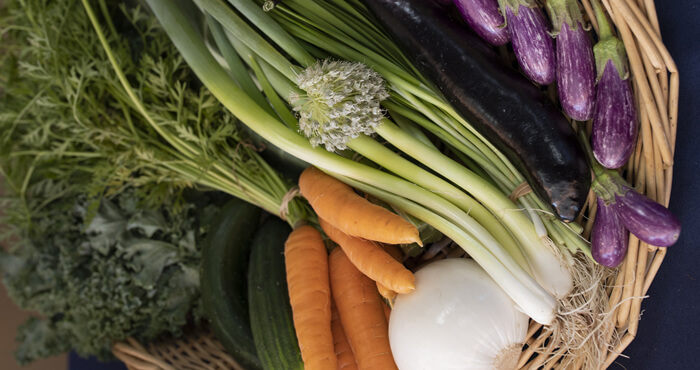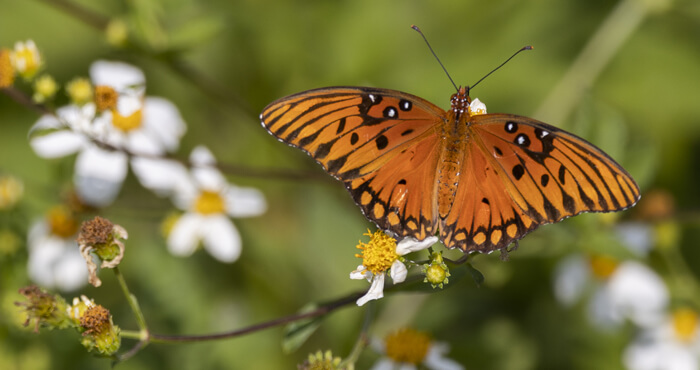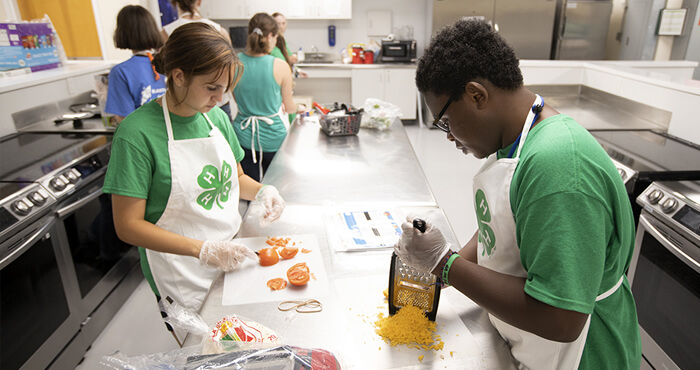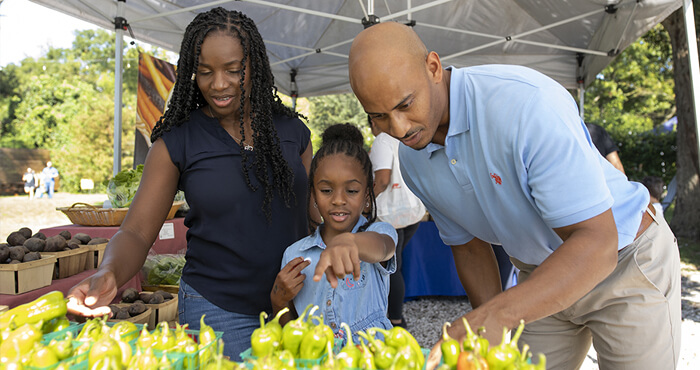
Spring Herbs
Herbs are grown for their special flavors and aromas that are used for seasoning, enriching and otherwise improving the taste and smell of food. In Florida, a number of common herbs can be planted in the spring.
Growing Herbs at Home
Most of the common herbs can be grown seasonally in Florida for home use. In South Florida, many herbs may be grown in the home garden throughout the year. These plants fall under one of three categories: annuals, biennials and perennials. Annuals complete their life cycle in one season. Biennials take two seasons to complete their life cycle. Perennials flower and produce seeds throughout their life cycle and live for longer than one season.
Because the plants are generally small and only a little is needed at any one time, herbs are perfect for container gardening. Containers can enhance the look of landscapes when arranged along the borders of driveways, sidewalks, and patios, or on porches and balconies. Hanging baskets are especially suitable. With special care and plenty of sunlight, a few herbs can be grown indoors. The culture of herbs in containers—including soil preparation and fertilizing—is similar to that for vegetables.
Alternatively, herbs’ attractiveness as ornamental plants allow them to be easily incorporated into the home landscape as either a border planting or part of a flower garden.
Suggested Herbs for Spring Planting
The following herbs are perfect for spring planting throughout most of the state. Some of them may even be planted during the winter months in South Florida.
Seeds and planting stock of common spring herbs are generally available at local stores or seed retailers. Some spring herbs may be harder to find but can generally be obtained from herb specialty businesses.
Anise
Anise (Pimpinella anisum) is a small annual grown for its seeds. Because of its many white flowers, the plant is attractive in a flower garden or as a border plant. Leaves may be used fresh. In South Florida, anise will also grow in the winter.
Harvest the seeds when they turn brown, separating the seeds from the fruiting structures (umbels). You may need to dry the umbels before the seeds can be separated, cleaned, and stored.
Basil
Sweet basil (Ocimum basilicum) is a pleasant-smelling annual with a spicy taste. Plant size ranges from small to large, and the leaf colors range from green to purple to variegated. Basil grows well in Florida and is attractive as a potted plant. Its leaves may be used fresh at any time or dried.
Borage
Borage (Borago officinalis) is also known as "burrage" and "common bugloss." It has a large, spreading habitat, whitish hairy bristles, and blue star-like flowers. The plant has an odor and flavor similar to cucumber. The flowers may be used fresh as a garnish for beverages and salads.
Cardamom
Cardamom (Elettaria cardamomum) contains a top that regrows each year from an underground rhizome. It reaches five to ten feet tall with two-foot-long pointed leaves. Small yellowish flowers form oblong ribbed capsules that contain seeds.
The seeds are used to give flavor and aroma to coffee, candies, cookies and other pastries. Dry the capsules in the sun for three days then thresh (separate) and store the seeds.
Chervil
Chervil (Anthriscus cerefolium) is an annual grown for its aromatic, decorative leaves. It tastes and smells like tarragon. Some forms of chervil have thick roots that can be eaten like carrots. Leaves should be picked as needed to garnish salads, soups and other foods.
Coriander
Coriander (Coriandrum sativum) is a small-leaved flowering annual grown mainly for its aromatic seeds. Its flowers make it attractive in the flower garden or landscape. The fresh foliage, also known as “cilantro,” is also used in cooking.
When the tiny fruits turn brown—about three months after seeding—remove them from the plant and dry them on a screen. Once dried, thresh (separate) the seeds and store them in a dry, airtight container.
Cumin
Cumin (Cuminum cyminum) is a small annual in the parsley family grown for its aromatic seeds. Although it is seldom grown in Florida, it may be adapted because it requires a long warm season. In most of Florida, cumin can be planted in the spring. In South Florida, you can start planting it in the fall.
Seeding structures should be harvested upon turning brown. After drying, thresh (separate) and store the seeds.
Horehound
Horehound (Marrubium vulgare) grows from one to three feet tall and has hairy leaves. It is a weed in many parts of the United States and grows quite well in Florida gardens. Leaves and stems are harvested as needed.
This herb is used in making horehound candy, which is thought to help relieve throat tickling and coughing.
Lemon Balm
Lemon balm (Melissa officinalis) is part of the mint family and grows easily in Florida. The plants have lemon-scented leaves and grow in clumps. The leaves and tender stems are used fresh or dried to add flavor and aroma to drinks, salads, or other dishes.
Lovage
Lovage (Levisticum officinale) smells, tastes and looks like celery leaves. The leaves and stems are used fresh as needed. Other useful parts are the seeds and oil extracted from the roots.
Marjoram
There are three kinds of marjoram commonly used as herbs: sweet marjoram (Origanum marjorana), pot marjoram (O. onites), and wild marjoram (O. vulgare). Only sweet and pot marjoram are usually grown in herb gardens. These plants are very similar to each other, but sweet marjoram tends to grow upright, while pot marjoram runs along the ground. Marjoram makes an excellent border planting for a flower garden.
The leaves are used fresh or dried.
Mint
The mints (Mentha) grow easily in the Florida garden. Spearmint (Mentha spicata) and peppermint (M. piperita)—along with apple and orange mints—are the most popular. The leaves and flowering tops are used fresh and dried. In Florida, many of the mints grow profusely in shade or full sun.
Oregano
There are two main types of oregano: Mexican (Lippia graveolens) and European (Origanum vulgare, also ‘wild marjoram’). The taste of the European type is much milder, but their use is the same.
Rosemary
Rosemary (Rosmarinus officinalis) is a hardy perennial evergreen shrub with a very spicy aroma. Small pink flowers form in the second or third year. The fresh or dried, mildly bitter-tasting leaves are used in cooking.
Sage
Sage (Salvia officinalis) is an attractive border plant with grayish-green, oblong leaves. Purple flowers bloom in the second year. The leaves can be used fresh or dried.
Summer Savory
This annual has upright, branching stems and gray-green, pointed leaves. It grows well in Florida but is slow to germinate. Savory’s small, pinkish white flowers make it suitable for a flower garden. The zesty, peppery tasting leaves may be picked and used as needed, either fresh or dried.
Thyme
Thyme (Thymus vulgaris), a shrubby plant, is found in a fairly wide variety of shapes and sizes. Usually, it is a small-growing plant with purplish flowers at the ends of the stems. You may need patience to grow thyme; in Florida seeds are slow to germinate, and seedlings make slow initial growth.
To use thyme, remove the top third of the plant when in full bloom and spread it on newspaper in a well-ventilated room. When the plant is dry, strip the leaves and flowering tops from the stem and store them in tightly closed containers.
Location
Only a small amount of space is required for an herb garden because you will only need a few plants of each type of herb. No matter what size, an organized garden can make the plants easier to care for.
Perennial herbs live from year to year, so group these plants together where they will not interfere with the preparation of the rest of the garden. Annual herbs should also be grouped together so that you can easily replant each year. When you plant herbs in a vegetable garden, space them so that you can care for the vegetables without affecting the herbs.
Soil Preparation
Most herbs will grow under the same sunlight and soil conditions—and with similar care—as vegetables. Check our vegetable gardening guide for more specific information about soil preparation, liming, fertilizing and watering.
Some herbs are sensitive to soil moisture conditions and need special care. Sage, rosemary and thyme require a well-drained, slightly moist soil, whereas parsley, chervil, and mint grow best in damp soil. Because herbs are shallow-rooting, adding organic matter to sandy soils is particularly beneficial.
Propagation
Most annual and biennial herbs are grown from seed sown in the spot where the plants will grow. Perennials grow best when started in plant beds or boxes using seed or cuttings, and then transplanted into the garden or growing containers.
A few herbs can also be propagated by cutting, simple layering or subdivision. Mint spreads by means of long roots called "runners," which can be transplanted.
Keep in mind that some herbs tend to proliferate and become weeds if allowed to grow.
Harvesting & Curing
The seeds, leaves, flowering tops and roots of herbs are used for flavoring purposes. Their flavor is generally due to oil in these parts. The flavor is retained longer if the herbs are harvested at the right time and properly cured and stored.
Leaves
Young, tender leaves can be gathered and used fresh at any time during the season. To save the leaves for later use, harvest them when the plants begin to flower and dry them rapidly in a well-ventilated, darkened room. If the leaves are dusty or gritty, wash them in cold water and drain them thoroughly before drying.
The tender-leaf herbs—such as basil and mint—must be dried rapidly away from the light in order to retain their green color and prevent them from molding. The less succulent leaf herbs, such as sage, rosemary, thyme and summer savory, contain less moisture and can be partially dried in the sun without affecting their color.
Seeds
Harvest seeds when they are mature or when their color changes from green to brown or gray. Dry the seeds thoroughly before storing them to prevent molding, loss of quality, or loss of viability for planting. Cure the seeds for several days in an airy room, and then a day or two in the sun.
Storage
When the leaves or seeds are dry, remove stems and other foreign matter. Pack the leaves and seeds in suitable containers to prevent the loss of the oils that give herbs their flavor. Glass, metal or cardboard containers that can be closed tightly will preserve the flavor and aroma. Glass jars should be painted or stored in a dark room to prevent the green leaves from being bleached by light.
For more information about herbs or gardening in general, contact your county Extension office.
Resources
Other UF/IFAS Sites
- Gardening Solutions
- Entomology and Nematology Department
- Environmental Horticulture Department
- FAWN: Florida Automated Weather Network
- Florida-Friendly Landscaping™ Program
- Florida Master Gardener Program
- IPM Florida
- Pesticide Information Office
UF/IFAS Publications
- Florida-Friendly Landscaping™ Program
- Central Florida Gardening and Landscaping Fact Sheets
- Starting a Garden
State & Federal Agencies
- Florida Department of Agriculture and Consumer Services (FDACS)
- Florida Department of Environmental Protection (FDEP)
- Florida Energy Systems Consortium (FESC)
- U.S. Environmental Protection Agency (EPA)
- USDA Plant Hardiness Zone Map--U.S. National Arboretum
Organizations & Associations
- American Community Gardening Association
- American Horticultural Society
- Florida Native Plant Society
- Florida Nursery, Growers and Landscape Association (FNGLA)
- North American Native Plant Society
Other Sites & Publications
UF/IFAS Mobile Web Apps



.jpg)

.jpg)
